 |

 |
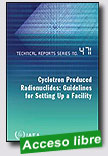 |
Cyclotron Produced Radionuclides: Guidelines for Setting up a Facility
Technical Reports Series No. 471 STI/DOC/010/471, 213 pp.
Cyclotrons are used for preparation of a wide variety of radionuclides that find application in single photon emission computed tomography (SPECT) as well as in positron emission tomography (PET). This publication gives comprehensive guidelines for the planning and decision making processes and design and implementation of a cyclotron based radionuclide production facility. It will enable Member States to plan such facilities in a cost effective manner. |
Extraído de:
http://www-pub.iaea.org/mtcd/publications/PubDetails.asp?pubId=8046
|
 |
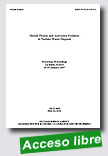 |
Mobile Fission and Activation Products in Nuclear Waste Disposal
Nuclear Energy Agency, 25 May 2009, 264 p
Workshop Proceedings, La Baule, France, 16-19 January 2007 - Most experts worldwide agree that disposal of spent nuclear fuel in appropriate formations deep underground provides a suitable option. Most public discussions about these underground repositories concentrate on the radiological hazard associated with the potential leak of actinides to the biosphere. However, the radiotoxicity of the fission products dominates the total radiotoxicity of the spent nuclear fuel during the first 100 years. Thereafter, their radiotoxicity diminishes and the long-term |
radiotoxicity becomes dominated by the actinides, mainly by the plutonium and americium isotopes.
The aim of the international workshop on Mobile Fission and Activation Products in Nuclear Waste Disposal, MOFAP07, was to review and to identify the needs for further studies on the transport and chemical behaviour of fission products in the geosphere for the safety assessment of radioactive waste repositories. These proceedings contain 22 peer-reviewed papers from the workshop, which should be of particular interest to professionals in the radioactive waste management field.
Extraído de:
http://www.nea.fr/html/pub/ret.cgi?id=new#6310
|
 |
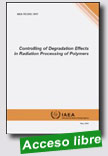 |
Controlling of Degradation Effects in Radiation Processing of Polymers
IAEA TECDOC, May 2009, 232 p
The interest of Member States of the IAEA in introducing radiation technology into the polymer and plastics industry is growing. This publication summarizes a number of studies conducted in the framework of a coordinated research project (CRP) on controlling of degradation effects on polymers by radiation processing technologies. It reviews a variety of applications and details the most important results and achievements of the participating centres and laboratories during the course of the CRP. The publication is intended to be of use to scientists implementing the technology and managers of radiation processing facilities.
|
Extraído de:
http://www-pub.iaea.org/MTCD/publications/PubDetails.asp?pubId=8063
|
 |
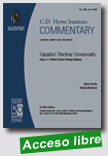 |
Nuclear energy has an important role to play in Canada’s electricity generation mix, based on cost and environmental grounds. Several hurdles remain to be cleared, however, according to a study released today by the C.D. Howe Institute. In Canada’s Nuclear Crossroads: Steps to a Viable Nuclear Energy Industry, authors Bruce Doern and Robert Morrison examine three key policy questions facing the nuclear industry – cost, privatization of Atomic Energy of Canada Limited (AECL), and regulation. They recommend steps to building a viable nuclear industry in Canada.
|
Extraído de:
http://www.cdhowe.org/index.cfm
|
 |
 |
New Nuclear Plants: An Engine for Job Creation, Economic Growth
Nuclear Energy Institute (NEI), 2009, 8 p.
The nuclear energy industry can play an important role in any program to stimulate creation of new jobs and economic expansion, providing both near-term and lasting employment and economic benefits. Nuclear energy is one of the few bright spots in the U.S. economy – expanding rather than contracting. This reflects a consensus that: any credible program to address climate change must include carbon-free technologies such as nuclear energy and renewable energy sources, and the United |
States needs new baseload generating capacity. For these reasons, financing support for new nuclear power plant construction should be included in any legislative package to provide stimulus for energy infrastructure development and job creation. The U.S. electric power industry is developing the first new nuclear projects in the United States since the late 1970s. These new reactor projects are in the early stages of development and start of construction is still three to five years away. Even so, the prospect of new nuclear plant construction already has stimulated significant investment and job creation among companies that supply equipment and services to the nuclear industry. At the end of 2008, NEI estimates that private investment in new nuclear power plants has created an estimated 14,000-15,000 jobs. Over the last several years, the nuclear industry has invested over $4 billion in new nuclear plant development, and plans to invest approximately $8 billion in the next several years to be in a position to start construction in 2011-2012. This near-term job creation is the leading edge of a larger surge in the medium- to long-term (2011 and beyond). With sufficient investment stimulus and financing support, job creation will continue to expand over the next five years and beyond. The number of new jobs will expand 2dramatically after 2011 when the first wave of these new nuclear projects starts construction. Absent investment stimulus, the current pace of job creation will slow and the prospect of tens of thousands of new U.S. jobs could recede into the distant future or disappear completely.These jobs represent a range of opportunities – from skilled craft employment in component manufacturing and plant construction, to engineering and operation of new facilities.
Extraído de:
http://www.nei.org/resourcesandstats/documentlibrary/newplants/whitepaper
/new-nuclear-plants-an-engine-for-job-creation-economic-growth/ |
 |
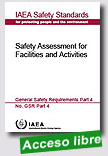 |
Safety Assessment for Facilities and Activities General Safety Requirements
IAEA Safety Standards Series, 2009, 40 p.
This publication describes the generally applicable requirements to be fulfilled in safety assessments for facilities and activities, with special attention paid to defence in depth, quantitative analyses and the application of a graded approach to the ranges of facilities and of activities that are addressed. The requirements provide a consistent and coherent basis for safety assessments, facilitating the transfer of good practices between organizations in this area.
|
Extraído de:
http://www-pub.iaea.org/MTCD/publications/PubDetails.asp?pubId=8081
|
 |
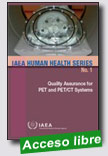 |
This publication provides guidelines for the implementation of quality assurance and control programmes concerning the combined medical diagnostic modality of positron emission tomography (PET) and computed tomography (CT). These independent, but complementary, imaging techniques are in frequent and increasing use within the fields of diagnostic imaging, oncology, cardiology and neurology, where they allow physicians to locate and diagnose malignant diseases accurately. This publication establishes guidelines for |
acceptance testing and routine quality control as necessary for optimal clinical performance. Specific topics of discussion include frameworks for reference values, tolerances and action levels, minimal required configurations with corresponding performances characteristics, and the management of ancillary equipment.
Extraído de:
http://www-pub.iaea.org/mtcd/publications/PubDetails.asp?pubId=8002
|
 |
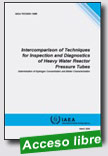 |
Intercomparison of Techniques for Inspection and Diagnostics of Heavy Water Reactor Pressure Tubes: Determination of Hydrogen Concentration and Blister Characterization
IAEA TECDOC Series, March 2009, 54 p.
To foster international collaboration in nuclear power technology, the IAEA has conducted a coordinated research project (CRP), Intercomparison of Techniques for Heavy Water Pressure Tube Inspection and Diagnostics. This publication presents the results of the second phase of the CRP, dealing with blister characterization by in situ non-destructive examination (NDE) techniques and determination of hydrogen concentration in zirconium alloy components.
|
|
 |
 |
Decision time - Driving the UK towards a sustainable future
Confederation of British Industry (CBI), 13 July 2009, 36 p.
The CBI is calling for a significant shift in the direction of UK energy policy, warning the current approach is making energy security harder to achieve and jeopardising our ability to meet climate change targets.
In a new report launched today (Monday 13th July) called Decision Time,the CBI warns that current policy is incentivising investments in wind power which will result in too little investment in other forms of low-carbon energy, such as nuclear and clean coal.
|
Instead the CBI wants the government to pursue policies that will deliver a more balanced energy mix that includes wind and other renewables, nuclear, gas, and clean coal. This will bolster energy security and help reduce carbon emissions more cost-effectively in tougher economic times.
Extraído de:
http://www.cbi.org.uk/ndbs/press.nsf/0363c1f07c6ca12a8025671c00381
cc7/a65ac8500938c7e1802575f3005c6a02?OpenDocument |
 |
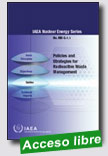 |
Policies and Strategies for Radioactive Waste Management
IAEA Nuclear Energy Series, 2009, 68 p.
To assure the safe, technically optimal and cost effective management of spent fuel and radioactive waste, appropriate policies and strategies are required. This publication clarifies the differences between a policy and a strategy, and provides principal advice to Member States on the typical composition, mutual links and the process of compilation of such documents. It also offers options for and indicates approaches to the management of spent fuel and radioactive waste, thus enabling an effective spent fuel and radioactive waste management infrastructure to be developed. |
| Extraído de:
http://www-pub.iaea.org/MTCD/publications/PubDetails.asp?pubId=8116
|
| |
|
